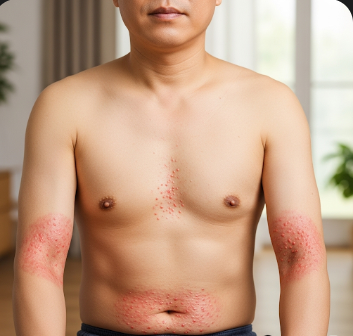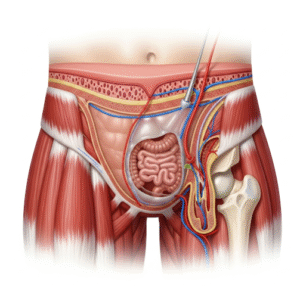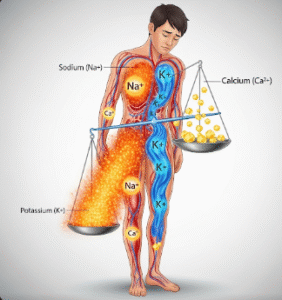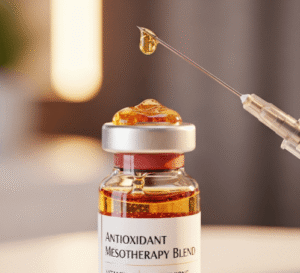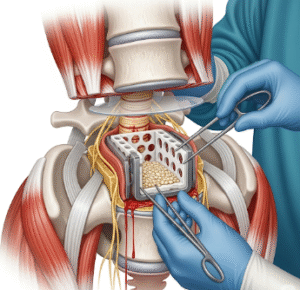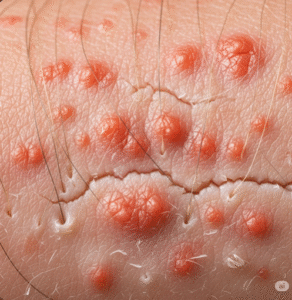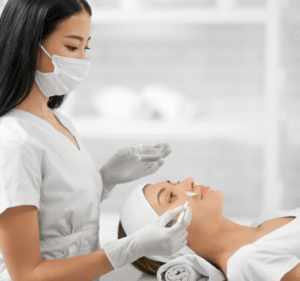Overview
Heat rash, also known as miliaria or prickly heat, is a common skin condition that occurs when sweat ducts become blocked, leading to trapped sweat under the skin. This results in red bumps, itching, and a prickling sensation, especially in hot and humid conditions.
Heat rash can affect all age groups, but it is especially common in infants and young children due to their immature sweat glands. In South Korea, dermatology clinics provide diagnosis, treatment, and preventive guidance for heat rash, ensuring comfort and preventing secondary infections.
Key Facts
🟢 ➤ Heat rash results from blocked sweat ducts causing trapped sweat beneath the skin.
🟢 ➤ Common in hot, humid climates and during periods of excessive sweating.
🟢 ➤ Symptoms include red bumps, itching, prickling, and sometimes small blisters.
🟢 ➤ Usually self-limiting, but severe cases may require medical attention to prevent infection.
🟢 ➤ Prevention includes staying cool, wearing breathable clothing, and maintaining good hygiene.
🟢 ➤ South Korean dermatology clinics offer effective treatments and patient education on preventive strategies.
What is Heat Rash?
Heat rash is a skin reaction caused by the obstruction of sweat glands, leading to accumulation of sweat under the skin.
Key points:
➤ Types of heat rash:
- Miliaria crystallina: tiny, clear, fluid-filled bumps.
- Miliaria rubra: red, itchy bumps; most common.
- Miliaria profunda: deeper, flesh-colored papules.
➤ Heat rash often occurs in areas where skin folds trap sweat, such as the neck, chest, back, groin, and underarms.
➤ While usually mild and self-limiting, severe or persistent cases can cause discomfort, infection, or scarring.
Symptoms Related to Heat Rash
Symptoms may vary depending on the type and severity of the rash:
🟢 ➤ Red, pink, or flesh-colored bumps on the skin.
🟢 ➤ Itching, prickling, or tingling sensations, especially in hot or humid conditions.
🟢 ➤ Small, fluid-filled blisters (miliaria crystallina) in mild cases.
🟢 ➤ Pain or irritation if the rash becomes inflamed or infected.
🟢 ➤ Heat rash may worsen with continued sweating or friction.
🟢 ➤ Infants may show fussiness or discomfort due to irritation.
Causes / Possible Causes
Heat rash occurs when sweat ducts become blocked, preventing sweat from reaching the skin’s surface.
Environmental Causes
➤ Hot and humid weather.
➤ Overdressing or wearing tight, non-breathable clothing.
➤ Prolonged physical activity causing excessive sweating.
Physiological Causes
➤ Immature sweat glands in infants.
➤ Excessive sweating due to fever or hyperhidrosis.
Other Contributing Factors
➤ Skin friction from tight clothing or straps.
➤ Occlusive ointments or creams that block sweat pores.
➤ Stress or emotional triggers increasing sweat production.
When Should I See a Doctor?
Consult a healthcare provider if:
🟢 ➤ Rash persists or worsens despite cooling and skin care measures.
🟢 ➤ Signs of infection appear, including pus, swelling, warmth, or increased pain.
🟢 ➤ Fever or systemic symptoms accompany the rash.
🟢 ➤ Heat rash occurs frequently or severely, affecting daily life.
Early consultation prevents secondary infections and complications, particularly in infants and immunocompromised individuals.
Care and Treatment
Management of heat rash focuses on cooling the skin, relieving discomfort, and preventing complications:
Home Care Measures
➤ Keep the affected area cool and dry.
➤ Wear loose, breathable clothing.
➤ Avoid heavy creams or ointments that block sweat ducts.
➤ Take cool baths or showers to soothe the skin.
➤ Avoid excessive sweating and reduce physical exertion temporarily.
Medical Management
➤ Mild corticosteroid creams or calamine lotion for itch relief and inflammation.
➤ Topical antibiotics if secondary bacterial infection develops.
➤ Antihistamines for severe itching in some cases.
Advanced Care in Korea
➤ South Korean dermatology clinics provide accurate diagnosis, prescription treatments, and laser therapy if needed.
➤ Patient education focuses on prevention, skin care, and monitoring for infection.
➤ Follow-up ensures complete resolution and minimizes recurrence.
Highlights (Clean Green Arrow Version)
🟢 ➤ Heat rash occurs when sweat ducts are blocked, causing trapped sweat under the skin.
🟢 ➤ Symptoms: red bumps, itching, prickling, small blisters, and discomfort in skin folds.
🟢 ➤ Causes: hot and humid weather, excessive sweating, tight clothing, immature sweat glands, or occlusive products.
🟢 ➤ Seek medical attention if rash persists, worsens, or shows signs of infection.
🟢 ➤ Treatment includes cooling measures, loose clothing, topical creams, and antihistamines if needed.
🟢 ➤ South Korea offers dermatology clinics with advanced treatments, patient education, and preventive guidance.

